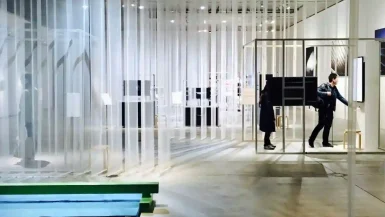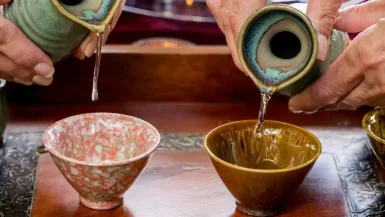Introduction
The Japanese tea ceremony, known as “sado” or “chanoyu,” is a centuries-old tradition. It symbolizes tranquility, respect, purity, and harmony. This guide explores the essence of the Japanese tea ceremony, providing travelers with insights into its history, significance, and how to experience it firsthand. Join us on this journey into one of Japan’s most revered cultural practices.
The History of the Japanese Tea Ceremony
Origins in China
The origins of the ceremony trace back to China. During the Tang Dynasty (618-907 AD), tea drinking became a ritualistic practice. Buddhist monks introduced this practice to Japan in the early 9th century. However, it wasn’t until the late 12th century that the Japanese tea ceremony began to take shape.
Evolution in Japan
The ceremony evolved significantly over the centuries. Initially, it was practiced mainly by the elite. Zen Buddhism influenced its development, emphasizing mindfulness and simplicity. In the 15th century, Murata Juko formalized the tea ceremony, establishing its core principles. Later, Sen no Rikyu, a tea master, refined the ceremony, making it a cultural cornerstone.
Influence of Zen Buddhism
Zen Buddhism profoundly influenced the ceremony. The principles of Zen, such as mindfulness, simplicity, and tranquility, are integral to the practice. The tea ceremony became a form of meditation, allowing participants to find inner peace and harmony.
The Significance of the Japanese Tea Ceremony
Symbolism and Philosophy
The ceremony is rich in symbolism. Each element represents core values of Japanese culture. The ritual embodies the philosophy of “wabi-sabi,” which finds beauty in imperfection and impermanence. The tea room’s simplicity and the utensils’ rustic charm reflect this philosophy.
The Four Principles: Harmony, Respect, Purity, and Tranquility
The Japanese tea ceremony revolves around four principles: harmony (wa), respect (kei), purity (sei), and tranquility (jaku). These principles guide every aspect of the ceremony, from the preparation of the tea to the interactions between the host and guests. Harmony fosters a sense of unity. Respect emphasizes gratitude. Purity ensures a serene environment. Tranquility promotes inner peace.

A Form of Art
The Japanese tea ceremony is considered a form of art. It combines elements of calligraphy, flower arrangement, ceramics, and architecture. The host’s movements, the tea room’s design, and the tea utensils’ aesthetics all contribute to this artistic expression.
The Components of the Japanese Tea Ceremony
The Tea Room (Chashitsu)
The tea room, or “chashitsu,” is a crucial element of the tea ceremony. Typically small and simple, it creates an intimate atmosphere. The tea room often features tatami mats, a low entrance, and minimal decorations. These elements promote humility and mindfulness.
Tea Utensils (Chadogu)
Tea utensils, or “chadogu,” are essential to the Japanese tea ceremony. Each tool has a specific purpose and meaning. The most important utensils include the tea bowl (chawan), tea whisk (chasen), tea scoop (chashaku), and tea caddy (natsume). These items are often handmade, reflecting the craftsmanship and aesthetics of Japanese culture.
The Host and Guests
The host plays a central role in the Japanese tea ceremony. They prepare and serve the tea, ensuring that every detail is perfect. The guests, on the other hand, participate respectfully, appreciating the host’s efforts and the tea’s quality. The interactions between the host and guests are guided by the principles of harmony, respect, purity, and tranquility.
The Process of the Japanese Tea Ceremony
Preparing the Tea Room
The preparation of the tea room is meticulous. The host cleans the room, arranges the utensils, and sets up the flower arrangement (chabana). The preparation reflects the principle of purity, creating a serene and welcoming environment.
Welcoming the Guests
The host welcomes the guests with a bow, symbolizing respect. Guests enter the tea room through a low entrance, promoting humility. They cleanse their hands and mouths using a bamboo ladle and stone basin, further emphasizing purity.
The Ritual of Making Tea
The tea-making process is the heart of the Japanese tea ceremony. The host carefully measures the tea powder, adds hot water, and whisks it to a frothy consistency. Each movement is deliberate and graceful, reflecting mindfulness and precision.
Serving the Tea
The host serves the tea to the guests, starting with the guest of honor. The guests receive the tea bowl with both hands, expressing gratitude. They admire the bowl’s craftsmanship before drinking the tea in small sips. This moment is about appreciating the tea and the effort put into its preparation.
Sharing a Meal
In a traditional ceremony, a light meal (kaiseki) may be served before the tea. The meal consists of seasonal dishes, beautifully presented and carefully prepared. Sharing a meal fosters a sense of community and harmony among the participants.
Expressing Gratitude
After drinking the tea, the guests express their gratitude to the host. This is done through a series of bows and respectful phrases. The ceremony concludes with the host cleaning the utensils and guests leaving the tea room quietly.
Experiencing the Japanese Tea Ceremony as a Traveler
Where to Experience the Japanese Tea Ceremony
Travelers can experience the tea ceremony in various locations across Japan. Kyoto, the cultural heart of Japan, offers numerous tea houses and temples where you can participate in a tea ceremony. Tokyo also has several places that provide authentic tea ceremony experiences. Additionally, many ryokan (traditional inns) across Japan offer tea ceremonies as part of their services.
Participating in a Tea Ceremony
Participating in a Japanese tea ceremony requires an understanding of basic etiquette. It’s important to arrive on time, dress modestly, and show respect to the host and other guests. Listen carefully to the host’s instructions and follow their lead. Taking photographs is usually not allowed, as it can disrupt the serene atmosphere.
Learning the Art of Tea
For those interested in learning more about the ceremony, several schools offer classes and workshops. These sessions provide in-depth knowledge about the tea ceremony’s history, philosophy, and techniques. It’s a wonderful opportunity to deepen your appreciation of this cultural practice.
Combining Tea Ceremony with Other Cultural Activities
Many travelers combine the tea ceremony with other cultural activities. For example, you can wear a kimono during the ceremony, enhancing the authenticity of the experience. Some tea houses also offer calligraphy or flower arrangement classes, allowing you to explore different aspects of Japanese culture.
The Impact of the Japanese Tea Ceremony on Modern Culture
Influence on Japanese Society
The ceremony continues to influence modern Japanese society. The principles of harmony, respect, purity, and tranquility are reflected in various aspects of daily life, from social interactions to business practices. The tea ceremony also promotes mindfulness and appreciation of the present moment, values that are increasingly important in today’s fast-paced world.
Global Recognition
The Japanese tea ceremony has gained global recognition as a symbol of Japanese culture. It has been practiced and appreciated by people worldwide, fostering cross-cultural understanding and appreciation. Many international cultural institutions and universities offer programs on the Japanese tea ceremony, further spreading its influence.
Contemporary Adaptations
While the traditional ceremony remains popular, contemporary adaptations have emerged. Some modern tea houses incorporate elements of Western culture, offering fusion experiences that blend traditional and modern practices. These adaptations make the tea ceremony more accessible to a global audience while preserving its core values.
Conclusion
The Japanese tea ceremony is a profound cultural practice that offers travelers a unique insight into Japan’s rich heritage. From its historical roots to its modern-day significance, the tea ceremony embodies the essence of Japanese culture. By participating in a Japanese tea ceremony, travelers can experience the tranquility, respect, purity, and harmony that define this ancient tradition. Whether you’re a cultural enthusiast or simply curious, the Japanese tea ceremony is an unforgettable experience that enriches your journey through Japan.



